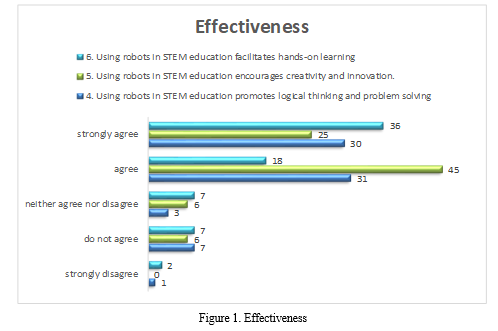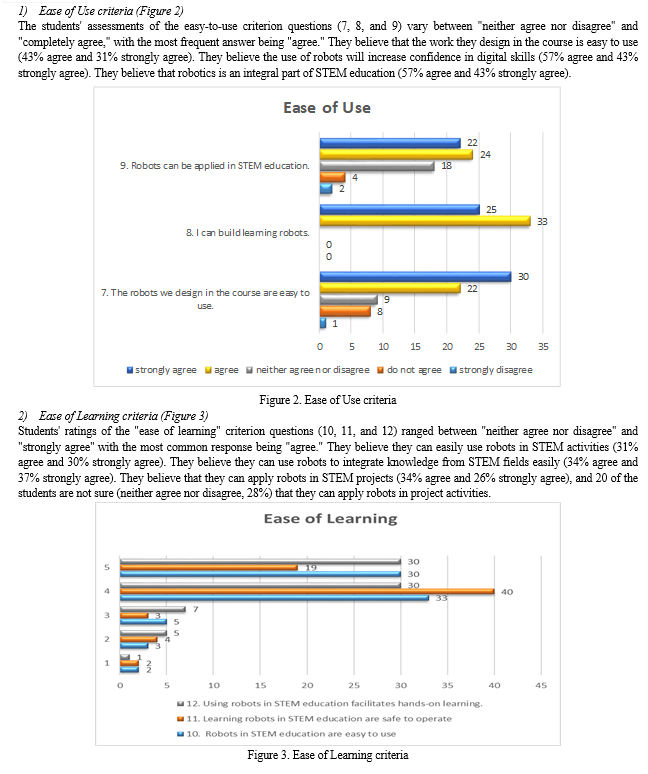Ijraset Journal For Research in Applied Science and Engineering Technology
- Home / Ijraset
- On This Page
- Abstract
- Introduction
- Conclusion
- References
- Copyright
Usability of Educational Robots in STEM Education
Authors: Emilia Tosheva, Sashko Plachkov
DOI Link: https://doi.org/10.22214/ijraset.2024.58725
Certificate: View Certificate
Abstract
Learning robots make it possible to teach science, technology, engineering, and mathematics (STEM) in a new and exciting way. Robotics provides a tangible and practical way for students to apply theoretical concepts from STEM subjects. Students can physically build, program, and interact with robots, leading to a deeper understanding of complex concepts. Purpose: This paper is an evaluation of the usability of educational robots in STEM (science, technology, engineering, and mathematics) education in teaching undergraduate students. Methods: A questionnaire based on the principles of usability according to ISO-9241 and the USE questionnaire proposed by Lund (2001), which examines usability. The evaluation criteria are effectiveness, efficiency, satisfaction, and ease of use. Results: According to the findings of 70 students who participated in the study, educational robots used in education today are quickly finding their place. They provide a new opportunity to improve the effectiveness of training and achieve better results. It is important when designing robotics programs to consider the usability of the robots to be used.
Introduction
I. INTRODUCTION
The modern education of the 21st century has entered the digital era 4.0, it must continue to innovate. Educational robotics is such an innovation that makes it an important component of modern education. Learning robots make it possible to teach science, technology, engineering and mathematics (STEM) in a new and exciting way. Robotics provides a tangible and practical way for students to apply theoretical concepts from STEM subjects, students can physically build, program and interact with robots, leading to a deeper understanding of complex concepts. Building and programming robots involves a series of challenges that require students to think critically and solve problems. It is important to note that the successful implementation of robots in STEM education relies on qualified teachers and appropriate educational resources. Educational robots are quickly finding a place in STEM education.
They are an interactive educational tool for STEM learning that allows students to actively participate through designing, building, and programming. STEM education has rapidly gained momentum in Bulgaria over the past few years, with STEM classrooms and labs being built where students can apply knowledge from different subject areas and use learning robots in various learning activities. A change is also needed in the curricula of students preparing to be teachers to be prepared in a digital world where robots are rapidly entering the educational process.
II. OBJECTIVE
The purpose of the study is for students to evaluate the utility of using robots in STEM education. In line with this objective, the following research questionsarise:
- How effective can learning robots be in engineering modelling?
- Are students satisfied with the use of robots in their studies?
- Are the learning robots easy to use?
III. LITERTURE REVIEW
Many authors point to different aspects of the usability of learning robots in education, such as high efficiency in teaching STEM [1], [2] usefulness [3], ease of learning [3], and satisfaction [4], [5]. The use of robotics in education helps students build skills such as creative thinking, problem solving, decision-making, collaboration, and communication skills [6]. Enhancing active learning and engagement in school [9]. The use of learning robots’ increases students' motivation, interest, self-esteem, and positive emotions [8]. Usability is defined as “the effectiveness, efficiency, and satisfaction with which specified users achieve specified goals in particular environments” [9].
From the ISO 9241-11 terminology, we can define usability by the three dimensions’ effectiveness, efficiency, and satisfaction. Effectiveness reflects “the accuracy and completeness with which users achieve specified goals," efficiency represents the “resources (time, human effort, costs, and materials) used in relation to the results achieved," and satisfaction is the “extent to which the user’s physical, cognitive, and emotional responses that result from the use of a system, product, or service meet the user’s needs and ex pectations” [10].
IV. METHOD AND METHODOLOGY
A. Study Design
After taking a Technical Modeling course, students appreciated the usefulness of using robots in STEM education. They evaluated the educational content of the "Educational Robotics" module from the "Technical Modeling" curriculum, included in the curriculum of students majoring in "Pedagogy of Technology and Entrepreneurship" at Neophyt Rilski University of Applied Sciences, Blagoevgrad, Bulgaria. For the purposes of the study, a questionnaire was created and tested. This evaluation serves to: design curricula, including educational robots; to help select teaching robots to be used in STEM education.
B. Questionnaire
The choice to use questionnaires for quantitative research is based on the fact that this method gives objective data that reflects reality and has a high degree of reliability. So specific trends. To assess teachers' attitudes towards the usability of robots in STEM education, an online questionnaire was developed with the capabilities of Google Forms. The questionnaire is based on the principles of usability according to ISO-9241 and the USE questionnaire proposed by Lund (2001), which examines usability. The study focused on four axes of usability evaluation: effectiveness, efficiency, satisfaction and ease of use, analyzed from a pedagogical and technological perspective. The questionnaire includes 11 questions, which are structured in 2 groups. The first group was aimed at assessing demographic data (questions 1–3) and the second group was aimed at assessing the usability of the learning robots (questions 4–11). Answers to the questions are on a 5-point Likert-type scale, in which: 1- strongly disagree; 2-disagree; 3-neither agree nor disagree; 4-agree; 5-strongly agree.
C. Stimulus Material
In order to assess the usability of the learning robots, students who completed the Engineering Modeling course were asked for their opinion on the usability of the robots included in an Educational Robotics module.
- Curriculum Technical Modeling
The purpose of the "Technical Modeling" course is to reveal the specifics of technical modeling in technology and entrepreneurship education. The main tasks arising from this goal are aimed at: familiarization with the basic concepts and methods in technical design, construction, and modeling; formation of knowledge, skills, and competences for modeling technical objects; forming knowledge, skills, and competences for building and programming educational robots; and forming knowledge, skills, and competences for creating technical models in a STEM educational environment. The content of the curriculum "Educational Robotics" module (Table 1).
Table 1. The Content of the Curriculum "Educational Robotics" Module
|
Module: Educational robotics |
|
|
A. LECTURES |
|
|
TOPIC |
GOALS |
|
-Acquisition of knowledge about robotics and robots. - Getting to know the principles of robotics, the functions and operation of robots. |
|
-Acquisition of knowledge and skills for constructing educational robots. -Introduction to modular construction systems. |
|
-Acquisition of robot programming knowledge and skills. -Familiarity with different learning robot programming environments. |
|
-Learning about robotic workplace models. -Creating a model of a robotic workplace. |
|
PRACTICAL EXERCISES |
|
|
-Application of knowledge, skills, and competences in the construction of educational robots. -Work with robot constructors. |
|
-Familiarity with block programming environments for robots. |
|
-Formation of skills for the development of a course assignment. |
|
-Submission and presentation of course assignments |
V. DISCUSSION AND FINDING
To evaluate the usefulness of using robots in STEM education, descriptive methods were used, which serve to classify and summarize the data in tabular, graphic, and analytical form. They provide an opportunity to obtain summaries of the data. Descriptive statistics deal with the aggregation of systematized data. It is of particular importance in empirical research and the description of experimental results. Through the methods of statistics, the data can be analyzed, taking into account the randomness and uncertainty of the observations, and on this basis, conclusions can be drawn about the regularities contained in them.
A. Demographics
No significant differences in students' responses on demographic grounds were observed. The study included students of different ages as (56%) of the respondents are aged between 18-24 years, (18%) are between 25-34 years old, (18 %) are between 35-44 years old and (42%) are over 44 years old. (40%), women and (48%) men were surveyed. Regardless of age and gender, the answers to the questions are close.
???????B. Evolution
The research focused on four criteria: usability, effectiveness, ease of use, efficiency, and satisfaction. Effectiveness criteria (Figure 1) Questions (4, 5, and 6) aim to explore the students' opinions about the usefulness of using learning robots in their education. Their assessment is positive (Figure 1). They believe that using robots will encourage logical thinking and problem solving (43% agree and 42% strongly agree). Students believe that using robots will encourage creativity and innovation. (31% agree and 55% strongly agree). They believe that using robots will facilitate hands-on learning. (51% agree and 26% strongly agree).



VI. ACKNOWLEDGMENT
This paper has been partially supported by scientific project number RP-B3/23 called: Building a STEM Center in Mechatronics
Conclusion
Educational robotics will play an increasingly important role in STEM education as it is an interactive, multidimensional and relevant way to prepare students for a new and digital world. The results of the study show that the usability of learning robots in STEM education is effective. Students are happy with using robots in their learning and find them easy to use. The questionnaire used in the study can be used to assess teachers\' attitudes when designing curricula with the application of learning robots in STEM education. Therefore, we believe that this article will be helpful in providing a STEM educational framework that enables students to acquire the fundamental skills and knowledge needed to solve real-world problems using educational robots.
References
[1] D.Bell, The reality of ???? education, design, and technology teachers’ per-ceptions: A phenomenographic study. Int J Technol Des Educ 26(1), 61-79. 2016. [2] F. Barreto, and V., Benitti, (2012). Exploring the educational potential of robotics in schools: A systematic review“, Computers & Education 58 (3), pp. 978-988. https://doi.org/10.1016/j.compedu.2011.10.006, April 2012J. Clerk Maxwell, “A Treatise on Electricity and Magnetism”, 3rd ed., vol. 2. Oxford: Clarendon, 1892, pp.68–73. [3] J. Lindh, T. Holgersson, (2007). Does lego training stimulate pupils\' ability to solve logical problems? Computers & Education,Volume 49, Issue 4, December 2007, Pages 1097-1111. DOI:10.1016/j.compedu.2005.12.008. [4] Gorov, K.,& Peykova, D., (2019). Garov, K., Peikova, D. (2019). Some aspects of STEM education in the primary and junior secondary stages of primary education. In Scientific conference \"Innovative Information and Communication Technologies for Digital Research Space in Mathematics, Informatics and Teaching Pedagogy\", Pamporovo. [5] Kozhuharova, D.,& Zhelyazkova, M., (2021). Essence of STEM education, (2021). Pedagogical Forum,3. DOI: 10.15547/PF.2021.016 [6] Albo-Canals, J., Heerink, M., Diaz, M., Padillo, V., Maristany, M., Barco, A., Rogers, C. (2013). Comparing two LEGO robotics-based interventions for social skills training with children with ASD. In: 22nd IEEE International Symposium on Robot and Human Interactive Communication, Gyeongju, Korea. [7] Henry, K., Knight, K., & Thornberry, T., (2012). School disengagement as a predictor of dropout, delinquency, and problem substance use during adolescence and early adulthood. Journal of Youth & Adolescence, 41(2), 156–166. doi:10.1007/s10964-011-9665-3 [8] R. Goldman, Amy Eguchi and El., Sklar. Using Educational Robotics to Engage Inner-City Students withTechnology. eBook ISBN9781410611017, 2004. [9] Shah SGS, Robinson I, AlShawi S., (2009). Developing medical device technologies from users’ perspectives: a theoretical framework for involving users in the development process. In: J Technol Assessment Health Care, 2009, 25(4), pp. 514–21. https://doi.org/10.1017/S0266462309990328 [10] Meyer, J., Gassert, R., & Lambercy, O., (2021). An analysis of usability evaluation practices and contexts of use in wearable robotics. Journal of NeuroEngineering and Rehabilitation 18 (1), DOI: 10.1186/s12984-021-00963-8
Copyright
Copyright © 2024 Emilia Tosheva, Sashko Plachkov. This is an open access article distributed under the Creative Commons Attribution License, which permits unrestricted use, distribution, and reproduction in any medium, provided the original work is properly cited.

Download Paper
Paper Id : IJRASET58725
Publish Date : 2024-03-01
ISSN : 2321-9653
Publisher Name : IJRASET
DOI Link : Click Here
 Submit Paper Online
Submit Paper Online

